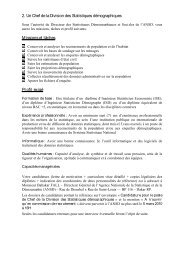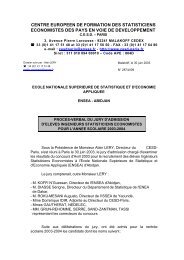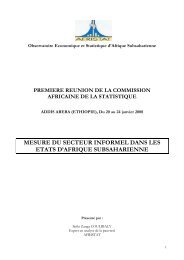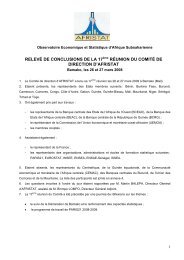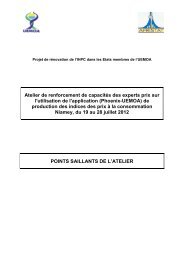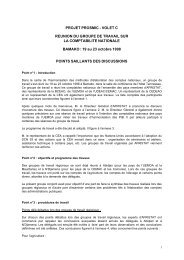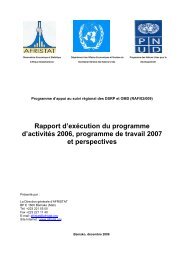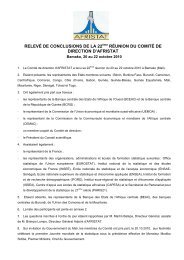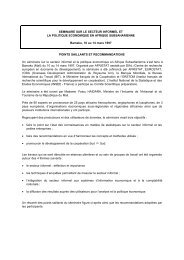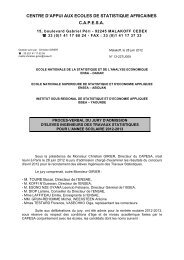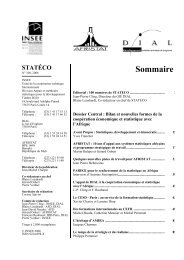Global Purchasing Power Parities and Real Expenditures - Afristat
Global Purchasing Power Parities and Real Expenditures - Afristat
Global Purchasing Power Parities and Real Expenditures - Afristat
You also want an ePaper? Increase the reach of your titles
YUMPU automatically turns print PDFs into web optimized ePapers that Google loves.
202 <strong>Global</strong> <strong>Purchasing</strong> <strong>Power</strong> <strong>Parities</strong> <strong>and</strong> <strong>Real</strong> <strong>Expenditures</strong>Basic heading. The lowest level of aggregation of items inthe GDP breakdown for which parities are calculated. Intheory, a basic heading is defined as a group of similar welldefinedgoods or services. In practice, it is defined by thelowest level of final expenditure for which explicit expenditureweights can be estimated. Thus, an actual basic headingcan cover a broader range of products than is theoreticallydesirable. Basic headings are the building blocks of a comparison.It is at the level of the basic heading that expendituresare defined, products selected, prices collected, pricesedited, <strong>and</strong> PPPs first calculated <strong>and</strong> averaged.Basket. A term often used for the common list of welldefinedgoods <strong>and</strong> services from which countries participatingin a comparison make a selection of products toprice for the purpose of compiling PPPs. Also referred to as“product list” or “item list.”Bias. A systematic error in a PPP or volume index. Bias canarise for a number of reasons, including failure to respecteither representativity, comparability, or consistency; theprice collection <strong>and</strong> measurement procedures followed; orthe calculation <strong>and</strong> aggregation formula employed.Bilateral comparison. See “binary comparison.”Binary comparison. A price or volume comparison betweentwo countries that draws upon data only for those twocountries. Also referred to as a “bilateral comparison.”Binary PPP. A PPP between two countries calculated usingonly the prices <strong>and</strong> weights for those two countries.Bridge country. A country that provides the link or bridgebetween two separate comparisons involving differentgroups of countries. The bridge country participates in bothcomparisons <strong>and</strong>, by doing so, enables the countries in onecomparison to be compared with the countries in the othercomparison <strong>and</strong> vice versa.Changes in inventories <strong>and</strong> valuables. Changes in inventories<strong>and</strong> valuables (including work in progress) consist ofchanges in (a) stocks of outputs that are still held by theunits that produced them before their being further processed,sold, delivered to other units, or used in other ways<strong>and</strong> (b) stocks of products acquired from other units thatare intended to be used for intermediate consumption orfor resale without further processing; they are measuredby the value of the entries into inventories, less the valueof withdrawals <strong>and</strong> the value of any recurrent losses ofgoods held in inventories. PPPs are not estimated directly;instead, they are imputed using PPPs for consumer goodsequipment.Characteristics. The physical <strong>and</strong> economic attributes of aproduct that serve to identify it <strong>and</strong> enable it to be locatedunder some heading of a product classification; the technicalparameters <strong>and</strong> price-determining properties of a productlisted in a product specification.Clothing <strong>and</strong> footwear. Includes expenditures on clothingmaterials; garments for men, women, <strong>and</strong> children; otherarticles of clothing <strong>and</strong> clothing accessories; cleaning, repair,<strong>and</strong> hire of clothing; all footwear for men, women, <strong>and</strong> children;<strong>and</strong> repair <strong>and</strong> hire of footwear.COFOG (classification of the functions of government).Classifies transactions by general government—includingoutlays on final consumption expenditure, intermediateconsumption, gross fixed capital formation, <strong>and</strong> capital <strong>and</strong>current transfers—by function or purpose. A major use ofCOFOG is to identify which final consumption expendituresof general government benefit households individually<strong>and</strong> which benefit households collectively.COICOP (classification of individual consumption accordingto purpose). Classifies the individual consumptionexpenditures of three institutional sectors—households,NPISHs, <strong>and</strong> general government—by the ends that theywish to achieve through these expenditures. Individualconsumption expenditures are those that are made forthe benefit of individual households. All final consumptionexpenditures by households <strong>and</strong> NPISHs are definedas individual, but only the final consumption expendituresby general government on individual services are treated asindividual.Collective consumption expenditure by government.<strong>Expenditures</strong> incurred by general <strong>and</strong> local governmentsfor collective consumption services such as defense, jus-



